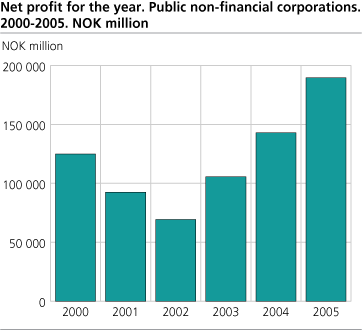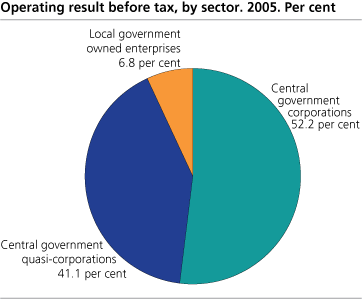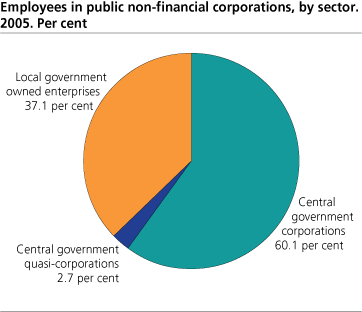Content
Published:
This is an archived release.
Oil and gas exploration gave good result
Public owned enterprises achieved a positive and increasing profit for the accounting year 2005. The high profit can mainly be attributed to the enterprises operating within oil, gas and mining. In addition profit was attributed to the corporations in electricity supply, transport and communication.
DiverseBoth the central and the local government have a significant ownership interest in Norwegian business and industry. The public companies vary both with regard to economic activities and importance for the Norwegian economy and employment. The level of ownership differs from the large stock exchange registered corporation to the small 100 per cent owned enterprise. These are engaged in activities such as oil and gas exploration, energy supply, transport, real estate operations and rehabilitation. Oil and gas is the dominating business areas and this include The State`s Direct Finance Investment (SDFI) and Statoil ASA among others. Corporations in the industry of transport and communications are the largest employers. In these industries we find enterprises such as Posten Norge AS, Telenor ASA and Norges Statsbaner AS. DevelopmentThere were about 2 680 public owned corporations at the end of 2005. This is almost 150 more than 2004. The number of enterprises has been increasing during the recent years. One explanation is improved method of data collection in Statistics Norway. Because of this, the increase from year to year will not be completely correct, especially for the significant increase from 2003 to 2004. Another reason is that some of the major enterprises have been reorganised either by take over or divestiture. |
Public corporations achieved some NOK 264 billion profits before tax in 2005. This is equivalent to 33.1 per cent pre-tax profit. The profit ratio is measured by profit before tax in per cent age of operating income. The corresponding figure for 2004 was about NOK 199 or 29.7 per cent.
The high profit can mainly be attributed to the mining and exploration of raw oil and natural gas that contributed about NOK 207 billion profit before tax or 78.6 per cent. SDFI and Statoil ASA were dominating corporations in this industry. The average price for North Sea (Brent crude oil) in 2005 was about USD 53.5 per barrel as against USD 38.1 in 2004.
2005 was the most profitable year in the period 2000-2005. Despite of the relatively high crude oil price from 2000 to 2002, the profit was then decreased. This came as a result of sale of central government shares in SDFI from 2001.
The electricity supply industry achieved a good year in 2005. The industry realised about NOK 33.4 billion profit before tax and NOK 25.3 billion net profit for the year. This was an increase of NOK 13.2 billion and NOK 10.2 billion respectively in relation to the profit for 2004. This came as a result of higher production by about 24.7 per cent together with higher domestic consumption by 2.0 per cent . Statkraft SF is the biggest corporation in this industry.
The transport and communication industry achieved some NOK 12.4 billion profits before tax and NOK 10.1 billion annual net profit for the year. This was about 12.2 per cent operating margin. Among the corporations in this industry were Telenor ASA, Posten Norge AS and Norges Statsbaner AS.
Central government owned corporations have the highest profit
The central government corporations and the central government quasi-corporations together accounted for some 93.2 per cent of the total profit before tax or about NOK 246 billion for the year. SDFI alone accounted for about NOK 110 billion . Among the major business units were Statoil ASA, Statkraft SF and Telenor ASA.
Energy supply was the main industry in the Local Government owned enterprises.
Moderate increase in asset value
Public corporations total assets value were about NOK 1 717 billion at the end of 2005. This was an increase of about 3.3 per cent as compare to the previous year. The fixed assets value increased by 1.1 per cent. On the other hand the current assets value relating to sales of goods and services increased by 15 per cent.
The value of the fixed asset has increased by 43 per cent since 2000. The most significant increase was from 2003 to 2004. The increase was mainly as a result of the establishment of the corporations such as Statkraft AS and Statkraft Energi AS and also because the Hafslund Group was not included in the statistics before 2004 after a takeover by Oslo municipality.
However, the capital is located in a small number of companies. Approximately 50 corporations contributed about 73 per cent of the total assets. Each of these corporations has over NOK 5 billion assets value. About 10 of these capital-intensive enterprises are Local Government owned enterprises and are located in the energy supply industry.
The financial situation
The public corporations (excluding the Central Government quasi-corporations) had a relatively stable financial structure in the period 2000 to 2005. If we disregard 2002 the equity ratio has been about 40 per cent. Furthermore, the ratio of fixed assets to long-term capital has been relatively stable and was about 1. In other words, fixed assets have been generally financed by long-term capital. The debt-equity ratio has been decreasing since 2002.
The current ratio had a moderate downward development from 2003. It was about 0.84 by 2005. By implication, current asset is lower than the current liabilities. The figures given do not necessary illustrate the enterprises liquidity and therefore require some careful consideration.
The central government quasi-corporations have been left out here because the equity in these corporations cannot be compared with other public corporations. The central government quasi-corporations comprises of the SDFI, Statens Kartverk, Statsbygg og Forsvarbygg together with other four hospital dispensaries. These corporations are wholly owned by the state.
Fewer employed
Some 125 000 people were employed by public owned non-financial corporations at the end of 2005. This is a decrease of about 10 000 people from 2000. The decrease is mainly related to fewer employees in the central government owned corporations. Furthermore, during the period, some large enterprises such as, SAS Norge AS, Navion AS and Norsk Medisinaldepot ASA no longer are classified as public corporations as the ownership interests no longer exceeds 50 per cent.
The Central government corporations had the largest number of employees. About 75 400 people were employed by the central government corporations at the end of 2005.
The central government quasi-corporations employed some 3 400 at the end of 2005. One of the reasons for the increase in the number of employees in 2002 was restructuring of Forsvarets Bygningstjeneste to Forsvarsbygg. At the same time incorporating the local central government quasi-corporations in the defence and military and the corresponding increase in responsibilities. Luftfartsverket was restructured to Avinor AS and consequently, from central government quasi-corporation to Central Government Corporation. This resulted in a significant reduction of employees in the central government corporations in 2003.
There has been a systematic increase in the number of people employed in the Local government owned enterprises during the period. About 46 600 people were employed by these enterprises at the end of 2005. Generally, no any enterprise had over 1 000 employees within the sector.
About the statisticsThe statistics include all market non-financial corporations in which the central government or municipalities/county municipalities directly or indirectly own more than 50 per cent of the shares. These include all companies incorporated by special legislation as well as central government market entities. Types of corporationsCentral and local governments are mainly engaged in the following types of corporations: - Private limited companies and public limited companies, including public corporations. - Central and local government market entities, so-called quasi-corporations. - Companies incorporated by special legislation. IFRS (International Accounting Standards)From 2005 accounting year, Norwegian companies registered in Oslo Stock Exchange can use international accounting standards. Nevertheless, Statistics Norway does not have well defined information about the population of public owned non-financial corporations that have started using the IFRS. Subsequently, the transition to international accounting standards can affect the comparability of the accounting figures, for example the value of assets. |
Tables:
- Table 1 Public non-financial corporations. Income statement. Selected accounting figures. NOK million and per cent. 2000-2005
- Table 2 Public non-financial corporations. Balance sheet. Selected accounting figures. NOK million and per cent. 2000-2005
- Table 3 Public non-financial corporations. Income statement and balance sheet by section. Selected accounting figures. NOK million. 2005
- Table 4 Public non-financial corporations, with out central government enterprises. Selected key figures. 2000-2005
- Table 5 Central government corporations. Income statement. Selected accounting figures. NOK million and per cent. 2000-2005.
- Table 6 Central government corporations. Balance sheet. Selected accounting figures. NOK million and per cent. 2000-2005
- Table 7 Central government corporations. Selected key figures. 2000-2005
- Table 8 Central government quasi- corporations. Income statement. Selected accounting figures. NOK million and per cent. 2000-2005.
- Table 9 Central government quasi- corporations. Income statement. Selected accounting figures. NOK million and per cent. 2000-2005
- Table 10 Local government owned enterprises. Income statement. Selected accounting figures. NOK million and per cent. 2000-2005
- Table 11 Local government owned enterprises. Balance sheet. Selected accounting figures. NOK million and per cent. 2000-2005
- Table 12 Local government owned enterprises. Selected key figures. 2000-2005
Contact
-
Francis Kwamena Acquah
E-mail: francis.kwamena.acquah@ssb.no
tel.: (+47) 40 90 26 62



